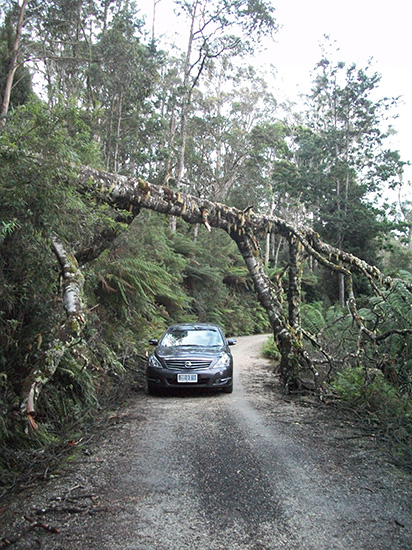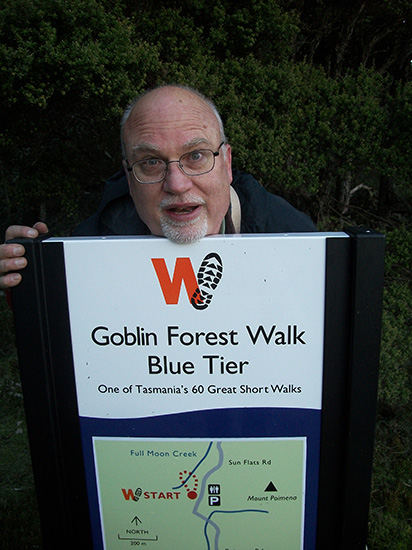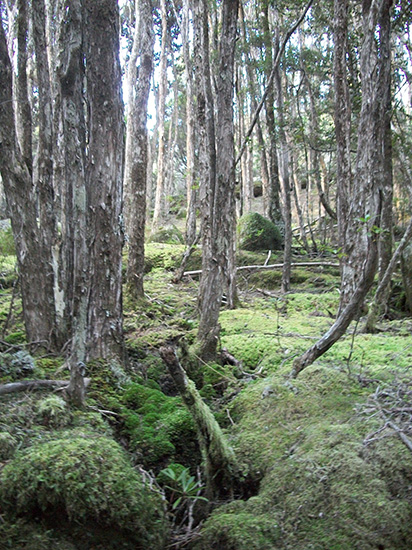From the Field: Bill Buck in Tasmania
Posted in Bill Buck, From the Field, Science on July 18 2011, by William R. Buck
Ed. note: The blogging bryologist, Mary Flagler Cary Curator of Botany, Bill Buck, is back! This time, Buck is reporting from Tasmania where he is researching mosses for a week before flying to Melbourne for the International Botanical Congress.
July 13, 2011; Weldborough, Tasmania, Australia

Today was mainly a travel day. Before leaving Hobart we ran by Paddy’s office to spread our still-wet specimens on his floor to dry while we are in the field. We headed north out of Hobart toward St. Helens. This town reminds me of some of the small coastal towns in Florida where I grew up, with touristy stores and lots of retirees. We lunched here and then turned inland to our collecting site of the day, the Blue Tier Forest Reserve.
We were a bit dismayed when we arrived at the road into the reserve only to find a “Road Closed” sign at the entrance. However, the road wasn’t blocked so we decided to chance it, which ended up being not nearly as bad a decision as it could have been; it seemed as if a road crew had preceded us! Many of the trees that appeared to have fallen across the road had already been cleared, and the one tree we found that was still over the road had amazingly fallen so that the large branches held the trunk off the ground and formed a kind of tree overpass.

Once under the tree, the road got narrower and began showing signs of erosion from previous heavy rains, but it was passable with only a minimal bottoming out of our rental car, though we did seem to be dragging branches under the car almost constantly. When the landscape leveled out, at about 700 meters, we came to a car park for the reserve. The air was decidedly cooler and the area around the parking lot was open, presumably kept so by grazing wallabies, based on the large number of droppings. There were several trail options for leaving the parking lot, and I just couldn’t resist the Goblin Forest Walk.
Like some of the other Tasmanian rain forests we have visited, this one is also magical. The forest is dominated by just two trees–wooly tea tree (Leptospermum lanigerum) and myrtle (Nothofagus cunninghamii)–while the forest floor is completely carpeted by bryophytes, with Sphagnum dominating this understory habitat. And thought it turns out that most of this moss carpet is limited in diversity, the tree trunks are rich in lichens and liverworts, including many we have not previously seen.

As I worked slowly along the trail I realized that my three companions must have chosen other trails, or else they would have caught up with me. I appreciated the short-lived solitude in this special place, so I took my time poking along and looking for interesting finds.
However, all good things must come to an end and we needed to get down past the worst parts of the road by dark. As we headed down the road we finally started seeing some of Tasmania’s native wildlife. First we saw the smaller of the two wallabies, the pademelon, which seemed, one after another, determined to jump out right in front of the car, causing us to advance carefully. Then the larger wallaby appeared, Bennett’s wallaby, several times larger than the pademelon. Next came a bandicoot (another marsupial) on the side of the road with its pointy snout and long tail, followed by a couple of others. Last to appear was a brushtail possum, which caused us to brake as it scurried across the road. Obviously dusk was the time for wildlife viewing in Tasmania! We’re still hoping to see at least two more Tasmanian natives, the wombat and the echidna. Maybe tomorrow.
About 6:00 p.m. we pulled into the small village of Weldborough where we had reservations to spend the night. We are staying in an old lodge which dates back to the 1920s, when the area had an active tin-mining industry. After unloading the car we hurried into dinner because they had opened the restaurant tonight only because our group is here. Obviously times have changed since this was a bustling commercial center until today when it is a sleepy backwater.
Perhaps it was all the wildlife we had seen driving into town (or maybe it was all the road kill?), but all three of my companions ordered wallaby for dinner. They claim it is very good but I still prefer my marsupials alive! Still, the atmosphere, with the fireplace warming the room whose walls have numerous pictures of the region’s heyday, is very relaxing after a day of driving on narrow, windy country roads. We all know we will sleep well tonight. Nevertheless, we are excited about tomorrow because we’re retuning to Blue Tier Nature Reserve. We hope to get a bit higher in elevation, which promises even greater bryodiversity, and then we will move onto several more localities before spending the night in another small rural town.
Photos by James Lendemer
To support Bill and the Garden’s other scientists in their plant science research efforts, please donate now and help support these expeditions and studies.
Bill Buck’s Previous Reports From the Field:
July 12, 2011; Hobart, Tasmania, Australia
July 11, 2011; Hobart, Tasmania, Australia
February 8, 2011; Punta Arenas, Chile
February 5, 2011, unnamed sound northwest of Isla Georgiana
February 4, 2011, unnamed sound directly east of Seno Mama, Chile
February 2, 2011, Seno Courtenay, northern arm, Chile
February 1, 2011, Seno Courtenay, Chile
January 31, 2011, Canal between Isla Georgiana and Isla Clementina,, Chile
January 30, 2011, Unnamed sound on south side of Brecknock Peninsula, NW of Isla Georgiana, Chile
January 29, 2011, Isla Aguirre, Seno Quo Vadis, Chile
January 26, 2011, Punta Arenas, Chile
January 24, 2011, Seno Chasco, just north of isthmus to Brecknock Peninsula, Chile
January 23, 2011, Isla Grande de la Tierra del Fuego, Puerto Consuelo, Seno Chasco, Chile
January 22, 2011, Isla Grande de la Tierra del Fuego, Seno Brujo, Chile
January 21, 2011, Isla Grande de la Tierra del Fuego, Seno Brujo, Chile
January 20, 2011, Isla Grande de la Tierra del Fuego, Seno Bluff, Chile

